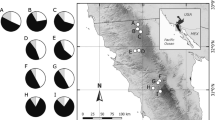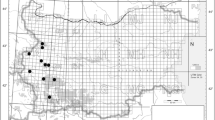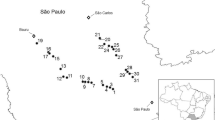Summary
The production of seedless fruits (parthenocarpy) is not yet understood from an evolutionary viewpoint, even though it is taxonomically widespread. Here I present a case in which parthenocarpy reduces the incidence of seed predation by insects. At least the first generation of chalcidoid wasps that oviposit in the fruits ofPistacia terebinthus L. (Anacardiaceae) cannot discriminate among viable and inviable fruits, allocating energy and time to oviposition on fruits that are not suitable for larval development.
Similar content being viewed by others
References
Crane, J.C. (1975) The role of seed abortion and parthenocarpy in the production of blank pistachio nuts as affected by rootstock.J. Am. Soc. Hort. Sci. 100, 267–70.
Darwin, C. (1876)The Variation of Animals and Plants Under Domestication, 2nd edn. D. Appleton and Co., NY, USA.
Davatchi, G.A. (1958) Étude biologique de la faune entomologique desPistacia sauvages et cultivés.Rev. Pathol. Veg. Ent. Agric. France 37, 5–166.
Grundwag, M. (1976) Embryology and fruit development in four species ofPistacia L. (Anacardiaceae)Bot. J. Linn. Soc. 73, 355–70.
Grundwag, M. and Fahn, A. (1969) The relation of embryology to the low seed set inPistacia vera (Anacardiaceae).Phytomorphology 19, 225–35.
Jordano, P. (1989) Pre-dispersal biology ofPistacia lentiscus (Anacardiaceae): cumulative effects on seed removal by birds.Oikos 55, 375–86.
Traveset, A. (1993) Weak interactions between avian and insect frugivores: the case ofPistacia terebinthus L. (Anacardiaceae).Vegetatio, (in press).
Willson, M.F. and Burley, N. (1983)Mate Choice in Plants. Princeton University Press, Princeton, USA.
Zangerl, A.R., Berenbaum, M.R. and Nitao, J.K. (1991) Parthenocarpic fruits in wild parsnip: decoy defence against a specialist herbivore.Evol. Ecol. 5, 136–45.
Zohary, M. (1952) A monographical study of the genusPistacia.Palestine J. Bot. Ser. 5, 187–238.
Author information
Authors and Affiliations
Rights and permissions
About this article
Cite this article
Traveset, A. Deceptive fruits reduce seed predation by insects inPistacia terebinthus L. (Anacardiaceae). Evol Ecol 7, 357–361 (1993). https://doi.org/10.1007/BF01237867
Issue Date:
DOI: https://doi.org/10.1007/BF01237867




